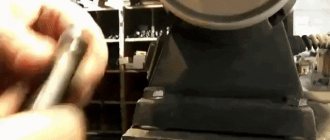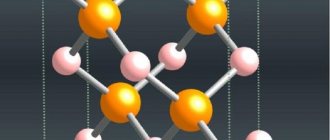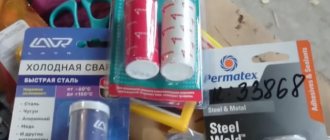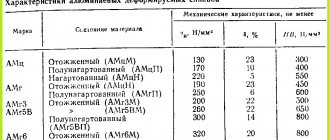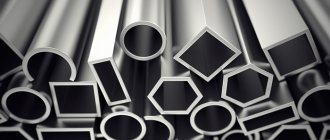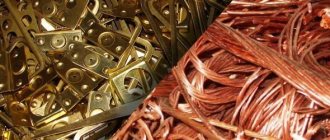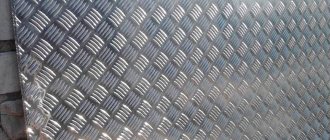What is it like?
Liquid and quite thick composition. Its viscosity is close to sunflower oil. Color varies from clear to dark brown. This variation is explained by the large number of ingredients included in it. Some high molecular weight compounds do not have a clearly defined structure. During storage of the finished product, minor color changes are also allowed. Performance does not depend on this in any way. Both dark and light flux behave equally well during soldering.
Born to be special
The creators have put a lot of effort into ensuring high flux activity for aluminum. F64 works powerfully, always achieving the maximum possible effect. No composition can boast of such fast tinning. The solder wets the metal without a hint of cold soldering. An extremely pleasant feature, with this unlimited power, is that there is less hissing and spattering than with soldering acid.
Application of aluminum
The widespread use of aluminum products lies primarily in the fact that it is a light metal. Aluminum is widely used in electrical engineering because it has excellent electrical conductivity.
For household needs, pots, cans, colanders, and mugs are made from this metal. Pure aluminum is used to produce foil used for electrolytic capacitors. It can also be used in the production of radiators.
However, soldering this metal can cause a lot of problems. This is explained by the fact that upon slight interaction with air, the surface of aluminum is covered with a thin but hard oxide film. It protects aluminum from further oxidation, but during the soldering process it creates a difficult barrier to overcome.
There are several methods to solve this problem, for example, soldering with rosin, but the best results are obtained by using fluxes specially designed for this.
Application area
Fluxes used to work with Al alloys are used to treat the surface of products in order to create a surface that can provide reliable contact with the solder.
Applicable:
- When creating elements of a heat-conducting system , for example, radiators.
- For use in electrical devices - to form a closed energy space.
- Connection of conductive wires.
- Production of any structures that require the use of various alloys and there is a need for electrical conductivity.
https://www.youtube.com/watch?v=ESFInizLE9U
Soldering problems
The melting point of aluminum does not exceed 660 degrees. The consequence of this is the use, for economic reasons, of welding machines that do not have too much power.
However, there is an oxide film on the surface of aluminum that must be removed before starting the welding process. But to melt it requires heating to a temperature of 2000 degrees. When this value is reached, not only the oxide film will be destroyed, but also the metal itself, which will lead to a deterioration in the quality of the welded joint. In addition, the oxide film can be restored after it has melted. Due to the stability of the oxide film, which has weak adhesion to solder, conventional solder has difficulty sticking to the surface of the part.
Aluminum soldering flux solves this problem. When applied to the welding area, it will block the passage of air into this area, which will lead to a weakening of the negative effects of the oxide film. Compared to other metals, such as iron and zinc, aluminum is more active - a cleaned part can instantly become covered again with an oxide film. Therefore, flux intended for aluminum parts is also required to act quickly.
Active flux for low-temperature soldering of aluminum will quickly dissolve the oxide film on the surface of products that interferes with the normal spreading of solder. In addition, zinc is added to the solder intended for joining aluminum products, which has the ability to dissolve well in aluminum.
A connection based on solder containing zinc has greater strength. By combining the appropriate solder and a universal flux for soldering aluminum, you can obtain a high-quality connection without much difficulty.
Soldering materials
To work with Al alloys, two main materials are used - solders and fluxes.
Solders
For soldering, you can use widely known low-melting solders:
- tin;
- zinc or cadmium based alloys;
The melting range is 200…400°C. This temperature background makes it possible to use a soldering tool that is not very powerful; moreover, the properties of the metal being processed do not change.
Refractory substances include alloys based on aluminum itself with additions of copper, zinc and silicon.
The main problem solved when using solders is the creation of a tinned layer on the surface of aluminum parts. This layer provides reliable adhesion, has a small electrical resistance bridge and can be processed during soldering.
Examples of solders used:
- Low-melting solder POS-40. Its composition includes 40% tin, 3...5% antimony, the rest is lead. The operating temperature range is 185…270°C. It is used to create low-impact products that are not subject to large mechanical loads, for example, simple seams.
- Refractory connection 34A. Used for working with aluminum and alloys - avial, duralumin, casting alloys. This solder is used for working with small parts, but it is necessary to avoid melting the parts being processed.
Fluxes
Solid flux
Various substances are used as fluxes to help neutralize the effects of the oxide film and create conditions for good solder adhesion.
They are produced industrially or prepared on their own using improvised materials.
Examples:
- Flux 34A. The action is based on a chemical effect on oxides, which are converted into substances that can interact with the surf. It is a strong oxidizing agent, therefore, after completion of soldering work, its residues must be removed.
- Machine oil. The principle is based on the mechanical removal of the protective oxide film using an abrasive material. The organic liquid prevents the access of atmospheric air to the cleaned surface, as a result of which metal oxidation does not occur. The surface becomes susceptible to contact with solders.
The choice of flux is influenced by the end result - be it making a simple weld, soldering electrical wires, or working with radio boards. In different operations, different mechanical strength of the joints and their electrical conductivity are achieved. An important fact is the temperatures developed during soldering work.
Liquid flux
Flux, according to its chemical composition, can be divided into two main groups:
- Solids , consisting of mixtures of salts and organic substances.
- Gel-like or liquid , containing acids, rosin, salts and organics.
Pros.
- Solid converters can be structurally made integral with solder, for example, in the form of a wire, the outer shell of which is a low-melting metal, the core is flux.
- The liquid consistency is technologically convenient to use - just dip the object being treated into the bath or rub the required area with the liquid.
- Remains of liquid components are easily removed with water.
Minuses:
- The use of solid substances is fraught with poisoning - under the influence of temperature when they melt, gaseous components can be released that are harmful to human health.
- Some types of flux are chemically aggressive substances that cause corrosion of treated surfaces.
- Some materials require a lot of electricity; the process, with small amounts of work, can take an unreasonably long time.
Features of the substance
Active flux for soldering aluminum has significant differences from similar substances used to join products made of steel, brass and copper, just as the properties of these metals themselves differ. The flux composition contains substances that can easily dissolve the oxide film on the surface of aluminum. For soldering aluminum products, fluxes of various numbers are used.
The simplest are fluxes No. 8 and 9, however, their activity is not too great compared to those that include fluorine compounds. The choice is made based on the characteristics of a particular job. There are fluxes that are used for welding joints of parts without prior preparation. The most common type of flux is F-64.
The composition of the flux for aluminum soldering, number F-64, contributes to its increased activity, which makes it possible to successfully clean even uncleaned surfaces from the oxide film. The solution is colorless or light yellow.
What can be soldered with flux for aluminum F-64:
- - twisting of aluminum wires
- - soldering of aluminum and copper wires (direct contact of these metals is highly undesirable)
- - capacitor flasks
- — Al wire to galvanized terminal
- - aluminum radiators
What to solder with?
Depending on the size of the parts, their heat capacity changes. And since we are also talking about the material used for radiators, a lot of heat will be needed. For wires with a cross-section of 1.5-2.5 mm2, a 40-watt soldering iron will be sufficient. For more than 2.5 mm2 you will already need a 60 - 80 Watt soldering iron. From 4 mm it is better to take 100 W. If we are talking about corners, then you will need a burner. Liquid flux is applied at the very end so that it does not have time to evaporate.
Solders used
When welding products made of aluminum, it is recommended to use solders from the tin-lead group. The highest quality connection can be obtained if you use a type of solder that contains elements such as silicon, zinc, and copper. The addition of additives significantly improves the quality of the solder - they lower its melting point, increase wettability, and make it more durable.
These types of solders are produced by domestic industry and foreign manufacturers. Tin-lead solders have the lowest melting point. One of the most common brands of solder for aluminum welding is HTS-2000. Experienced welders say that HTS-2000 solder should only be used with flux to obtain a high-quality connection.
Good substances in this area also include solder from the French company Castolin 192FBK, as well as Castolin 1827 solder, used when joining parts made of aluminum and copper. The domestic analogue of HTS-2000 is SUPER A+ solder, manufactured in Novosibirsk, which is used in conjunction with SUPER FA flux.
Methods of application and price
Example of aluminum wire processing:
- The protective braid is removed. Open ends are smoothed with a knife or sanding material.
- The surface is degreased using acetone , gasoline or solvent.
- The prepared products are immersed in a bath with the selected liquid flux.
- The treated ends are tinning with a low-melting surf.
- Remains of flux are removed with hot, then cold water, and wiped dry.
Ready-made industrial designs cost:
- F-61A – 50...100 rub. per bottle 30 ml.
- F-59A – 55...75 rub. for a container of 30 ml.
- Castolin 1827 aluminum-copper solder , 5 rods – 750...900 rub.
Adviсe:
- In order to create a reliable connection , it is advisable to use industrially produced substances.
- For household use, it is better to use fluxes designed to work with low-melting solders.
- to select a soldering material for the metals that are intended to be joined.
- A more reliable connection of parts will be obtained if you use a soldering iron equipped with an ultrasonic nozzle for soldering.
Flux F-61
An option such as F-61 flux is worthy of special attention. It refers to a type of active flux for removing oxides from the surface of aluminum products intended for soldering. At the same time, it improves the spreading process of liquid solder. Flux F-61A can also be used when joining aluminum and aluminum-based alloys with copper and steel products. What sets it apart from the entire group of similar elements is that it is made on the basis of fluoroborates.
Flux F-61A produced by REXANT is a low-temperature flux. It is used when soldering aluminum using solders belonging to the tin-lead group. The temperature regime is in the range of 150-320 degrees.
F-61A flux has the following composition:
- triethanolamine - 82 percent;
- zinc fluoroborate - 10 percent;
- ammonium fluoroborate - 8 percent.
The flux is packaged in dark glass bottles containing 30 milliliters of substance each. The dimensions of the bottle are on average 35x20 with a height of 76 millimeters. The weight of the bottle is about 0.03 kilograms. For ease of use, the bottle is equipped with a dropper, which makes it possible to use the flux in doses.
The flux complies with the requirements of the regulatory document OST 4 GO.033.200. Its price is affordable. Flux F-61A is supplied with instructions for use, which must be carefully studied before use. In particular, it specifies safety precautions during welding.
If flux gets on the welder’s skin, you should immediately wash the area with soapy water and wipe dry with a clean cloth. Bottles with flux must be stored in such a way that they cannot fall into the hands of children. The guaranteed shelf life is one year. After the process is completed, the remaining flux is removed using a cloth moistened with water or alcohol.
Self-production
It is possible to make flux for soldering aluminum with your own hands. Substances that have good solubility and antioxidant properties are suitable for production. When preparing flux for aluminum with your own hands, alcohol, acids, and oils are used as a basis.
The simplest flux can be prepared by dissolving a tablet of acetylsalicylic acid, best known as aspirin, in water. The tablet should be dissolved until the sediment disappears. You can also use citric acid granules.
A good flux can be obtained by dissolving rosin in ethyl alcohol. Since it dissolves slowly, it should be crushed as thoroughly as possible. To complete dissolution, the solution should be left for some time. This process can be accelerated by placing the solution in a glass jar and heating it in a water bath to a temperature of 80 degrees.
The advantage of flux obtained from rosin dissolved in alcohol is its neutrality, which allows its residues not to be washed off after the soldering process is completed. It is allowed to dissolve not in ethyl alcohol, but in glycerin. This flux will be thicker and more convenient to use.

